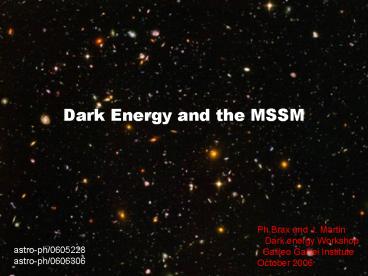Dark Energy and the MSSM - PowerPoint PPT Presentation
1 / 26
Title:
Dark Energy and the MSSM
Description:
Quintessence and Attractors: most quintessence models with ... Gravity tests are only relevant for nearly massless quintessence, Newton's law becoming ... – PowerPoint PPT presentation
Number of Views:61
Avg rating:3.0/5.0
Title: Dark Energy and the MSSM
1
Dark Energy and the MSSM
Ph.Brax and J. Martin Dark energy Workshop
Galileo Galilei Institute October 2006
astro-ph/0605228 astro-ph/0606306
2
Dark Energy in Broken Supergravity
- General Framework
- Coupling the Observable, Hidden and Dark
Energy sectors - Breaking susy and soft Terms
- Electroweak symmetry breaking
- Gravity tests
- Chameleon effect
- The SUGRA quintessence model
- Sugra model coupled to susy breaking
- Cosmological consequences
- Gravity tests
3
Motivation
- Quintessence and Attractors
- most quintessence models with insensitivity
to initial conditions require an attractor
mechanism - Inverse power law potentials, exponential
potentials - Large values of
- Supergravity can handle large field values
and connects gravity with high energy physics
4
Supergravity Framework
Observable
Hidden
Gravitational Interaction
Gravitational Interaction Interaction
Gravitational Interaction
Dark Energy
5
Three Sectors
- Hidden sector
- Kahler potential
- Superpotential
- Observable Sector
- Kahler potential
- Superpotential
- Dark Energy sector
- Kahler potential
- Superpotential
- Fields
- Quintessence field
6
Spontaneous Susy Breaking
- Susy broken in the Hidden sector
- Parameterised by the vevs
- Susy broken by the F-term vevs
- The gravitino mass
7
The Effective Theory
- After susy breaking, effective theory for
Observable sector coupled to Dark Energy - The Dark Energy potential
- with
- highly dependent on
the susy breaking sector
8
The Soft Breaking Terms
- Susy , spontaneously broken, leads to soft terms
- Soft terms depend on the dark energy sector
9
Gaugino Masses
- Gauginos acquire a mass depending on the gauge
coupling function - The mass depends on the F-terms breaking
supersymmetry - The gauge coupling dependence on the dark energy
sector leads to variations of constants
10
Electro-weak Symmetry Breaking
- The Higgs potential depends on the dark energy
sector via the soft terms evaluated at the
electro-weak scale - The two Higgs vevs depend on quintessence too
- The angle depends on quintessence
11
Boson and Fermion Masses
- The Higgs scale becomes (large
regime) - The gauge boson masses depend on quintessence
- The matter Fermion masses depend on quintessence
12
Violation of the Weak Equivalence Principle
- At the microscopic level, particles of types u or
d do not have the same mass dependence on
quintessence WEP violation - Coupling to matter
- Scalar-tensor effective action
- Need to analyse the WEP violation for
macroscopic bodies
13
Fifth Force
- Gravity tests are only relevant for nearly
massless quintessence, Newtons law becoming - Cassini experiments constraint
- The gravitational coupling constant
- At the microscopic level,
14
Variation of Constants
- The gauge coupling constants at the weak scale
- The fine structure constant at the weak scale
- The proton to electron mass ratio varies
15
Macroscopic Violation of WEP
- The mass of elements dominated by QCD
- The WEP violation
- as a function of
16
Chameleon Effect
- In the presence of matter, the quintessence
potential is modified - depends on the neutralino mass matrix
- Same effect for Baryon, could alleviate gravity
tests. - Depends on the QCD gauge function mainly.
Possible link with variation of constants.
17
The SUGRA Model
- Ignoring coupling to the Hidden and Observable
sector - Assuming
, the scalar
potential becomes - Phenomenologically interesting as equation of
state -0.82
18
Fine-Tuning of Parameters
- For a GUT scale model , see-saw mechanism
- and
for - Control of Kahler expansion, need extra symmetry,
e.g. modular invariance
19
Stabilised Hidden sector
- Coupling to hidden sector with
- Compatible with
- Explicit example
- leads to
20
Massive Quintessence Field
- In this context, the Dark Energy potential
becomes - Compensator coming from the Hidden sector
- Mass term due to the gravitino mass, evading
gravity tests.
21
Cosmological Evolution
- Quintessence field stabilised at small value
- Quintessence field convergence to minimum before
BBN - Cosmological evolution equivalent to a pure
cosmological constant both at the background and
perturbative levels - Hidden sector modifies dynamics
22
Runaway Potential
- Runaway potentials may be possible with
non-trivial hidden sector dynamics - Simplest assumption
- More complex cases, need a case by case analysis
- Explicit knowledge of the electroweak and gravity
sectors
23
Electroweak Breaking
- Boson masses depend on the quintessence sector in
a calculable way - No gauge coupling variation in this model
- The Weinberg angle is constant
- The angle varies with the quintessence
field - When cosmological evolution known, can back track
the physical observables
24
(No Transcript)
25
Gravity Tests
- Fifth force
- Weak Equivalence Principle
- Proton to Electron mass ratio
- Incompatible with attractor mechanism
26
Conclusion
- General framework to couple Dark Energy, Hidden
and Observable sectors in supergravity - Tension between cosmology and gravity tests
- Tension between cosmology and particle physics
requirements - Need to build realistic models with broken susy,
cosmological attractor and small gravitational
couplings - Chameleons and neutralinos?
- Prospects moduli fields.































